Unmounted UV Fused Silica Reflective ND Filters
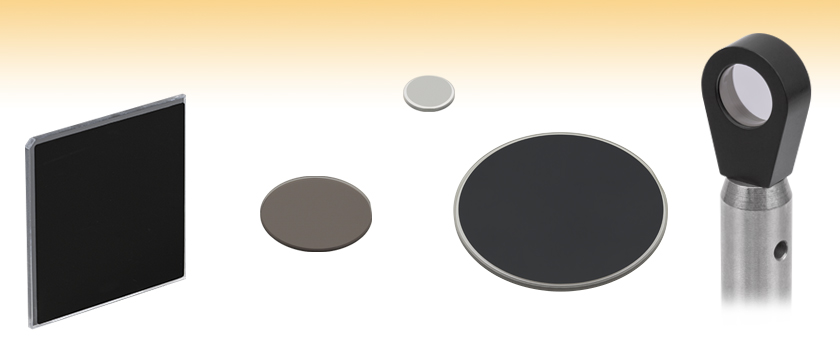
- UV to IR Spectral Range (200 - 1200 nm)
- Metallic Nickel Coating on UV Fused Silica Substrate
- Optical Densities from 0.1 to 4.0 Available
NDUV240B
Unmounted 50 mm x 50 mm
UVFS Reflective ND Filter, OD: 4.0
NDUV20B
Unmounted Ø25 mm UVFS Reflective ND Filter, OD: 2.0
NDUV503B
Unmounted Ø1/2" UVFS
Reflective ND Filter, OD: 0.3
NDUV2R06B
Unmounted Ø50 mm UVFS Reflective ND Filter, OD: 0.6
Application Idea
The NDUV505B UVFS Reflective ND Filter in an LMR05 Lens Mount
(Sold Separately)

Please Wait
| Neutral Density Filter Selection Guide |
|
|---|---|
| Absorptive | |
| Uncoated (400 - 650 nm) |
Mounted |
| Unmounted | |
| Uncoated (1000 - 2600 nm) |
Mounted |
| Unmounted | |
| AR Coated (350 - 700 nm) |
Mounted |
| Unmounted | |
| AR Coated (650 - 1050 nm) |
Mounted |
| Unmounted | |
| AR Coated (1050 - 1700 nm) |
Mounted |
| Unmounted | |
| Variable | |
| Reflective | |
| UV Fused Silica (200 - 1200 nm) |
Mounted |
| Unmounted | |
| N-BK7 (350 - 1100 nm) |
Mounted |
| Unmounted | |
| ZnSe (2 - 16 µm) |
Mounted |
| Unmounted | |
| Wedged UVFS (200 - 1200 nm) |
|
| Wedged N-BK7 (350 - 1100 nm) |
|
| Wedged ZnSe (2 - 16 µm) |
|
| Variable | |
| Neutral Density Filter Kits | |
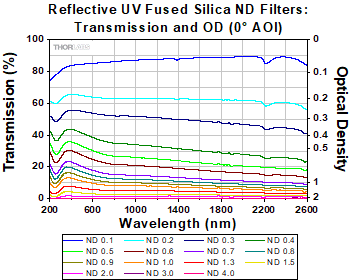
Click to Enlarge
Transmission and Optical Density of Reflective UVFS ND Filters
Features
- Optimized for Light Attenuation in the UV
- Available in Ø1/2", Ø25 mm, Ø50 mm, and 50 mm x 50 mm Sizes
- Optical Densities Available from 0.1 - 4.0
- Spectral Range: 200 - 1200 nm
Thorlabs offers reflective neutral density (ND) filters made from UV fused silica substrates with nickel coatings deposited on one side, which provide a flat spectral response. These unmounted, metallic filters are usable in the 200 - 1200 nm spectral range and are available in Ø1/2", Ø25 mm, Ø50 mm, and 50 mm x 50 mm versions. Each filter sold here includes a small, flat ground edge to visually distinguish it from our unmounted N-BK7 reflective ND filters. For other mounting options and wavelength ranges, please see the Selection Guide table on the right.
The UV fused silica substrate used in these filters exhibits high transmission and virtually no laser-induced fluorescence, as measured at 193 nm, making it an ideal choice for applications from the UV to the near IR. While the spectral range's lower limit of 200 nm is limited by the absorption of the light by the substrate, UV fused silica provides good transmission up to 2.1 µm, and thus the upper limit of 1200 nm is dependent on the increased opacity of the nickel coating. The optical density (OD) for each filter is specified at the design wavelength of 300 nm to facilitate their use in the UV; some variation in the OD will occur over the usable range. For plots showing the typical performance of the filters from 200 to 2600 nm, click on ![]() in the row corresponding to the desired filter in the tables below.
in the row corresponding to the desired filter in the tables below.
Unprotected metal coatings like this should only be cleaned by blown air, never touched, as contact may cause scratching to the unprotected surface. Although these are reflective ND filters, the nickel coating does absorb some of the incident light, which limits the use of these filters to low-power applications. Nickel is resistant to aging under normal conditions; however, it will oxidize at elevated temperatures. To prevent oxidation, Thorlabs recommends using these ND filters at temperatures below 100 °C. To achieve the best performance, light should be incident on the side with the nickel coating; this allows attenuation to occur before etalon effects occur within the filter's substrate.
Optical Density and Transmission
Optical density (OD) indicates the attenuation factor provided by an optical filter, i.e. how much it reduces the optical power of an incident beam. OD is related to the transmission, T, by the equation

where T is a value between 0 and 1. Choosing an ND filter with a higher optical density will translate to lower transmission and greater absorption of the incident light. For higher transmission and less absorption, a lower optical density would be appropriate. As an example, if a filter with an OD of 2 results in a transmission value of 0.01, this means the filter attenuates the beam to 1% of the incident power. Please note that the transmission data for our neutral density filters is provided in percent (%).
Please note that these products are not designed for use as laser safety equipment. For lab safety, Thorlabs offers an extensive line of safety and blackout products, including beam blocks, that significantly reduce exposure to stray light.
| Filter Dimensions | Ø1/2" | Ø25 mm | Ø50 mm | 50 mm x 50 mm |
|---|---|---|---|---|
| Substrate Material | UV Fused Silicaa | |||
| Front Surface Coating | Nickel | |||
| Spectral Range | 200 - 1200 nm | |||
| Optical Density Toleranceb | ±5% | |||
| Optic Dimension Tolerance | +0.00 / -0.20 mm | |||
| Clear Aperture | >90% of Outer Diameter | >Ø45.0 mm | >45.0 mm x 45.0 mm | |
| Filter Thickness | 1 mm | 2 mm | ||
| Thickness Tolerance | ±0.10 mm | |||
| Surface Flatness @ 633 nm | <2λ | <2λ per 25 mm | ||
| Parallelism | <20 arcmin | <30 arcsec | ||
| Surface Quality | 40-20 Scratch-Dig | |||
| Operating Temperaturec | <100 °C | |||
| Optical Density | Damage Threshold |
|---|---|
| 0.3 | 0.025 J/cm2 (355 nm, 10 ns, 10 Hz, Ø0.772 mm) |
| 1.0 | 0.05 J/cm2 (355 nm, 10 ns, 10 Hz, Ø0.772 mm) |
| 2.0 | 0.075 J/cm2 (355 nm, 10 ns, 10 Hz, Ø0.772 mm) |
| Damage Threshold Specifications | |
|---|---|
| Optical Density | Damage Threshold |
| 0.3 | 0.025 J/cm2 (355 nm, 10 ns, 10 Hz, Ø0.772 mm) |
| 1.0 | 0.05 J/cm2 (355 nm, 10 ns, 10 Hz, Ø0.772 mm) |
| 2.0 | 0.075 J/cm2 (355 nm, 10 ns, 10 Hz, Ø0.772 mm) |
Damage Threshold Data for Thorlabs' UV Reflective ND Filters
The specifications to the right are measured data for Thorlabs' UV reflective neutral density filters. Damage threshold specifications are constant for a given optical density, regardless of the size of the filter.
Laser Induced Damage Threshold Tutorial
The following is a general overview of how laser induced damage thresholds are measured and how the values may be utilized in determining the appropriateness of an optic for a given application. When choosing optics, it is important to understand the Laser Induced Damage Threshold (LIDT) of the optics being used. The LIDT for an optic greatly depends on the type of laser you are using. Continuous wave (CW) lasers typically cause damage from thermal effects (absorption either in the coating or in the substrate). Pulsed lasers, on the other hand, often strip electrons from the lattice structure of an optic before causing thermal damage. Note that the guideline presented here assumes room temperature operation and optics in new condition (i.e., within scratch-dig spec, surface free of contamination, etc.). Because dust or other particles on the surface of an optic can cause damage at lower thresholds, we recommend keeping surfaces clean and free of debris. For more information on cleaning optics, please see our Optics Cleaning tutorial.
Testing Method
Thorlabs' LIDT testing is done in compliance with ISO/DIS 11254 and ISO 21254 specifications.
First, a low-power/energy beam is directed to the optic under test. The optic is exposed in 10 locations to this laser beam for 30 seconds (CW) or for a number of pulses (pulse repetition frequency specified). After exposure, the optic is examined by a microscope (~100X magnification) for any visible damage. The number of locations that are damaged at a particular power/energy level is recorded. Next, the power/energy is either increased or decreased and the optic is exposed at 10 new locations. This process is repeated until damage is observed. The damage threshold is then assigned to be the highest power/energy that the optic can withstand without causing damage. A histogram such as that below represents the testing of one BB1-E02 mirror.

The photograph above is a protected aluminum-coated mirror after LIDT testing. In this particular test, it handled 0.43 J/cm2 (1064 nm, 10 ns pulse, 10 Hz, Ø1.000 mm) before damage.

| Example Test Data | |||
|---|---|---|---|
| Fluence | # of Tested Locations | Locations with Damage | Locations Without Damage |
| 1.50 J/cm2 | 10 | 0 | 10 |
| 1.75 J/cm2 | 10 | 0 | 10 |
| 2.00 J/cm2 | 10 | 0 | 10 |
| 2.25 J/cm2 | 10 | 1 | 9 |
| 3.00 J/cm2 | 10 | 1 | 9 |
| 5.00 J/cm2 | 10 | 9 | 1 |
According to the test, the damage threshold of the mirror was 2.00 J/cm2 (532 nm, 10 ns pulse, 10 Hz, Ø0.803 mm). Please keep in mind that these tests are performed on clean optics, as dirt and contamination can significantly lower the damage threshold of a component. While the test results are only representative of one coating run, Thorlabs specifies damage threshold values that account for coating variances.
Continuous Wave and Long-Pulse Lasers
When an optic is damaged by a continuous wave (CW) laser, it is usually due to the melting of the surface as a result of absorbing the laser's energy or damage to the optical coating (antireflection) [1]. Pulsed lasers with pulse lengths longer than 1 µs can be treated as CW lasers for LIDT discussions.
When pulse lengths are between 1 ns and 1 µs, laser-induced damage can occur either because of absorption or a dielectric breakdown (therefore, a user must check both CW and pulsed LIDT). Absorption is either due to an intrinsic property of the optic or due to surface irregularities; thus LIDT values are only valid for optics meeting or exceeding the surface quality specifications given by a manufacturer. While many optics can handle high power CW lasers, cemented (e.g., achromatic doublets) or highly absorptive (e.g., ND filters) optics tend to have lower CW damage thresholds. These lower thresholds are due to absorption or scattering in the cement or metal coating.

LIDT in linear power density vs. pulse length and spot size. For long pulses to CW, linear power density becomes a constant with spot size. This graph was obtained from [1].

Pulsed lasers with high pulse repetition frequencies (PRF) may behave similarly to CW beams. Unfortunately, this is highly dependent on factors such as absorption and thermal diffusivity, so there is no reliable method for determining when a high PRF laser will damage an optic due to thermal effects. For beams with a high PRF both the average and peak powers must be compared to the equivalent CW power. Additionally, for highly transparent materials, there is little to no drop in the LIDT with increasing PRF.
In order to use the specified CW damage threshold of an optic, it is necessary to know the following:
- Wavelength of your laser
- Beam diameter of your beam (1/e2)
- Approximate intensity profile of your beam (e.g., Gaussian)
- Linear power density of your beam (total power divided by 1/e2 beam diameter)
Thorlabs expresses LIDT for CW lasers as a linear power density measured in W/cm. In this regime, the LIDT given as a linear power density can be applied to any beam diameter; one does not need to compute an adjusted LIDT to adjust for changes in spot size, as demonstrated by the graph to the right. Average linear power density can be calculated using the equation below.

The calculation above assumes a uniform beam intensity profile. You must now consider hotspots in the beam or other non-uniform intensity profiles and roughly calculate a maximum power density. For reference, a Gaussian beam typically has a maximum power density that is twice that of the uniform beam (see lower right).
Now compare the maximum power density to that which is specified as the LIDT for the optic. If the optic was tested at a wavelength other than your operating wavelength, the damage threshold must be scaled appropriately. A good rule of thumb is that the damage threshold has a linear relationship with wavelength such that as you move to shorter wavelengths, the damage threshold decreases (i.e., a LIDT of 10 W/cm at 1310 nm scales to 5 W/cm at 655 nm):

While this rule of thumb provides a general trend, it is not a quantitative analysis of LIDT vs wavelength. In CW applications, for instance, damage scales more strongly with absorption in the coating and substrate, which does not necessarily scale well with wavelength. While the above procedure provides a good rule of thumb for LIDT values, please contact Tech Support if your wavelength is different from the specified LIDT wavelength. If your power density is less than the adjusted LIDT of the optic, then the optic should work for your application.
Please note that we have a buffer built in between the specified damage thresholds online and the tests which we have done, which accommodates variation between batches. Upon request, we can provide individual test information and a testing certificate. The damage analysis will be carried out on a similar optic (customer's optic will not be damaged). Testing may result in additional costs or lead times. Contact Tech Support for more information.
Pulsed Lasers
As previously stated, pulsed lasers typically induce a different type of damage to the optic than CW lasers. Pulsed lasers often do not heat the optic enough to damage it; instead, pulsed lasers produce strong electric fields capable of inducing dielectric breakdown in the material. Unfortunately, it can be very difficult to compare the LIDT specification of an optic to your laser. There are multiple regimes in which a pulsed laser can damage an optic and this is based on the laser's pulse length. The highlighted columns in the table below outline the relevant pulse lengths for our specified LIDT values.
Pulses shorter than 10-9 s cannot be compared to our specified LIDT values with much reliability. In this ultra-short-pulse regime various mechanics, such as multiphoton-avalanche ionization, take over as the predominate damage mechanism [2]. In contrast, pulses between 10-7 s and 10-4 s may cause damage to an optic either because of dielectric breakdown or thermal effects. This means that both CW and pulsed damage thresholds must be compared to the laser beam to determine whether the optic is suitable for your application.
| Pulse Duration | t < 10-9 s | 10-9 < t < 10-7 s | 10-7 < t < 10-4 s | t > 10-4 s |
|---|---|---|---|---|
| Damage Mechanism | Avalanche Ionization | Dielectric Breakdown | Dielectric Breakdown or Thermal | Thermal |
| Relevant Damage Specification | No Comparison (See Above) | Pulsed | Pulsed and CW | CW |
When comparing an LIDT specified for a pulsed laser to your laser, it is essential to know the following:

LIDT in energy density vs. pulse length and spot size. For short pulses, energy density becomes a constant with spot size. This graph was obtained from [1].
- Wavelength of your laser
- Energy density of your beam (total energy divided by 1/e2 area)
- Pulse length of your laser
- Pulse repetition frequency (prf) of your laser
- Beam diameter of your laser (1/e2 )
- Approximate intensity profile of your beam (e.g., Gaussian)
The energy density of your beam should be calculated in terms of J/cm2. The graph to the right shows why expressing the LIDT as an energy density provides the best metric for short pulse sources. In this regime, the LIDT given as an energy density can be applied to any beam diameter; one does not need to compute an adjusted LIDT to adjust for changes in spot size. This calculation assumes a uniform beam intensity profile. You must now adjust this energy density to account for hotspots or other nonuniform intensity profiles and roughly calculate a maximum energy density. For reference a Gaussian beam typically has a maximum energy density that is twice that of the 1/e2 beam.
Now compare the maximum energy density to that which is specified as the LIDT for the optic. If the optic was tested at a wavelength other than your operating wavelength, the damage threshold must be scaled appropriately [3]. A good rule of thumb is that the damage threshold has an inverse square root relationship with wavelength such that as you move to shorter wavelengths, the damage threshold decreases (i.e., a LIDT of 1 J/cm2 at 1064 nm scales to 0.7 J/cm2 at 532 nm):

You now have a wavelength-adjusted energy density, which you will use in the following step.
Beam diameter is also important to know when comparing damage thresholds. While the LIDT, when expressed in units of J/cm², scales independently of spot size; large beam sizes are more likely to illuminate a larger number of defects which can lead to greater variances in the LIDT [4]. For data presented here, a <1 mm beam size was used to measure the LIDT. For beams sizes greater than 5 mm, the LIDT (J/cm2) will not scale independently of beam diameter due to the larger size beam exposing more defects.
The pulse length must now be compensated for. The longer the pulse duration, the more energy the optic can handle. For pulse widths between 1 - 100 ns, an approximation is as follows:

Use this formula to calculate the Adjusted LIDT for an optic based on your pulse length. If your maximum energy density is less than this adjusted LIDT maximum energy density, then the optic should be suitable for your application. Keep in mind that this calculation is only used for pulses between 10-9 s and 10-7 s. For pulses between 10-7 s and 10-4 s, the CW LIDT must also be checked before deeming the optic appropriate for your application.
Please note that we have a buffer built in between the specified damage thresholds online and the tests which we have done, which accommodates variation between batches. Upon request, we can provide individual test information and a testing certificate. Contact Tech Support for more information.
[1] R. M. Wood, Optics and Laser Tech. 29, 517 (1998).
[2] Roger M. Wood, Laser-Induced Damage of Optical Materials (Institute of Physics Publishing, Philadelphia, PA, 2003).
[3] C. W. Carr et al., Phys. Rev. Lett. 91, 127402 (2003).
[4] N. Bloembergen, Appl. Opt. 12, 661 (1973).
In order to illustrate the process of determining whether a given laser system will damage an optic, a number of example calculations of laser induced damage threshold are given below. For assistance with performing similar calculations, we provide a spreadsheet calculator that can be downloaded by clicking the button to the right. To use the calculator, enter the specified LIDT value of the optic under consideration and the relevant parameters of your laser system in the green boxes. The spreadsheet will then calculate a linear power density for CW and pulsed systems, as well as an energy density value for pulsed systems. These values are used to calculate adjusted, scaled LIDT values for the optics based on accepted scaling laws. This calculator assumes a Gaussian beam profile, so a correction factor must be introduced for other beam shapes (uniform, etc.). The LIDT scaling laws are determined from empirical relationships; their accuracy is not guaranteed. Remember that absorption by optics or coatings can significantly reduce LIDT in some spectral regions. These LIDT values are not valid for ultrashort pulses less than one nanosecond in duration.

A Gaussian beam profile has about twice the maximum intensity of a uniform beam profile.
CW Laser Example
Suppose that a CW laser system at 1319 nm produces a 0.5 W Gaussian beam that has a 1/e2 diameter of 10 mm. A naive calculation of the average linear power density of this beam would yield a value of 0.5 W/cm, given by the total power divided by the beam diameter:

However, the maximum power density of a Gaussian beam is about twice the maximum power density of a uniform beam, as shown in the graph to the right. Therefore, a more accurate determination of the maximum linear power density of the system is 1 W/cm.
An AC127-030-C achromatic doublet lens has a specified CW LIDT of 350 W/cm, as tested at 1550 nm. CW damage threshold values typically scale directly with the wavelength of the laser source, so this yields an adjusted LIDT value:

The adjusted LIDT value of 350 W/cm x (1319 nm / 1550 nm) = 298 W/cm is significantly higher than the calculated maximum linear power density of the laser system, so it would be safe to use this doublet lens for this application.
Pulsed Nanosecond Laser Example: Scaling for Different Pulse Durations
Suppose that a pulsed Nd:YAG laser system is frequency tripled to produce a 10 Hz output, consisting of 2 ns output pulses at 355 nm, each with 1 J of energy, in a Gaussian beam with a 1.9 cm beam diameter (1/e2). The average energy density of each pulse is found by dividing the pulse energy by the beam area:

As described above, the maximum energy density of a Gaussian beam is about twice the average energy density. So, the maximum energy density of this beam is ~0.7 J/cm2.
The energy density of the beam can be compared to the LIDT values of 1 J/cm2 and 3.5 J/cm2 for a BB1-E01 broadband dielectric mirror and an NB1-K08 Nd:YAG laser line mirror, respectively. Both of these LIDT values, while measured at 355 nm, were determined with a 10 ns pulsed laser at 10 Hz. Therefore, an adjustment must be applied for the shorter pulse duration of the system under consideration. As described on the previous tab, LIDT values in the nanosecond pulse regime scale with the square root of the laser pulse duration:

This adjustment factor results in LIDT values of 0.45 J/cm2 for the BB1-E01 broadband mirror and 1.6 J/cm2 for the Nd:YAG laser line mirror, which are to be compared with the 0.7 J/cm2 maximum energy density of the beam. While the broadband mirror would likely be damaged by the laser, the more specialized laser line mirror is appropriate for use with this system.
Pulsed Nanosecond Laser Example: Scaling for Different Wavelengths
Suppose that a pulsed laser system emits 10 ns pulses at 2.5 Hz, each with 100 mJ of energy at 1064 nm in a 16 mm diameter beam (1/e2) that must be attenuated with a neutral density filter. For a Gaussian output, these specifications result in a maximum energy density of 0.1 J/cm2. The damage threshold of an NDUV10A Ø25 mm, OD 1.0, reflective neutral density filter is 0.05 J/cm2 for 10 ns pulses at 355 nm, while the damage threshold of the similar NE10A absorptive filter is 10 J/cm2 for 10 ns pulses at 532 nm. As described on the previous tab, the LIDT value of an optic scales with the square root of the wavelength in the nanosecond pulse regime:

This scaling gives adjusted LIDT values of 0.08 J/cm2 for the reflective filter and 14 J/cm2 for the absorptive filter. In this case, the absorptive filter is the best choice in order to avoid optical damage.
Pulsed Microsecond Laser Example
Consider a laser system that produces 1 µs pulses, each containing 150 µJ of energy at a repetition rate of 50 kHz, resulting in a relatively high duty cycle of 5%. This system falls somewhere between the regimes of CW and pulsed laser induced damage, and could potentially damage an optic by mechanisms associated with either regime. As a result, both CW and pulsed LIDT values must be compared to the properties of the laser system to ensure safe operation.
If this relatively long-pulse laser emits a Gaussian 12.7 mm diameter beam (1/e2) at 980 nm, then the resulting output has a linear power density of 5.9 W/cm and an energy density of 1.2 x 10-4 J/cm2 per pulse. This can be compared to the LIDT values for a WPQ10E-980 polymer zero-order quarter-wave plate, which are 5 W/cm for CW radiation at 810 nm and 5 J/cm2 for a 10 ns pulse at 810 nm. As before, the CW LIDT of the optic scales linearly with the laser wavelength, resulting in an adjusted CW value of 6 W/cm at 980 nm. On the other hand, the pulsed LIDT scales with the square root of the laser wavelength and the square root of the pulse duration, resulting in an adjusted value of 55 J/cm2 for a 1 µs pulse at 980 nm. The pulsed LIDT of the optic is significantly greater than the energy density of the laser pulse, so individual pulses will not damage the wave plate. However, the large average linear power density of the laser system may cause thermal damage to the optic, much like a high-power CW beam.
| Posted Comments: | |
Zsolt Nagy
(posted 2023-10-18 07:42:49.643) Hello,
The parallelism spec for 1/2" ND filters (NDUV5xxB) is up to 20 arcmin. Actually, that value is not very much different from wedged filters (30 +/-10 arcmin).
Is that spec really 20 arcmin, or actually 20 arcsec, just mistyped? cdolbashian
(posted 2023-10-27 11:28:21.0) Thank you for reaching out to us with this inquiry Zsolt! Unfortunately, this is indeed the true spec for this component. This is a result of our manufacturing process, and at the time of posting, we are working to improve our process in order to reduce this wedge size. Canh Doan
(posted 2023-08-02 17:17:06.677) Hi, Can you estimate the CW damage threshold of the Unmounted UV Fused Silica Reflective ND Filters with Nickel coating? jpolaris
(posted 2023-08-07 05:39:34.0) Thank you for contacting Thorlabs. At this moment we do not have comprehensive CW LIDT data for our reflective UVFS ND filters. I have reached out to you directly to discuss the use of these filters in your application. Minjie Zhan
(posted 2023-04-12 13:01:37.62) Hello,
How do you distinguish which is the coated side on NDUV01B? The reflection is so low that it's almost not possible to judge by eye. cdolbashian
(posted 2023-04-13 11:28:18.0) Thank you for reaching out to us. Nominally these components will be bi-directional since it is a nickel coating on a UVFS substrate. In the event that it matters to your application, I have emailed you with some guidelines regarding the determination of the reflective vs non-reflective sides. Giulio Maria Rossi
(posted 2023-03-23 16:04:25.367) Good afternoon,
I would like to know if it is possible to customize the reflective neutral density filters as follows:
- Use a 1 mm thick CaF2 substrate instead of FS
- Have a diameter 1.5 inch, or at least 30 mm
I would be interested in purchasing 2x ND0.1, 2x ND0.2 and 2x ND0.3.
Thank you,
Giulio Maria Rossi jdelia
(posted 2023-03-30 11:28:50.0) Thank you for contacting Thorlabs. We are reaching out to you directly to discuss the feasibility of your custom request. user
(posted 2023-03-03 10:14:27.797) How to transform the damage threshold under pulse laser into the damage threshold under continuous wave jgreschler
(posted 2023-03-09 04:05:36.0) Thank you for reaching out to Thorlabs. Since the physical damage mechanism for pulsed damage is different to that of CW damage there isn't any way to directly translate the two numbers. I've reached out to you directly to discuss some alternatives. user
(posted 2023-01-23 22:09:07.81) For mounted/unmounted Ø25 mm UVFS reflective ND filters, what product would be equivalent to a blank? WG41010 seems close, but is more than double the price of a UVFS filter. In order to preserve timing, even when I don't want to attenuate power, I still need to transmit my beam through something. cdolbashian
(posted 2023-01-27 04:57:13.0) Thank you for reaching out to us with this inquiry. The WG41010 would indeed be the best choice here, as it is the identical substrate and thickness of your ND filter. Eden L
(posted 2022-09-18 21:30:34.067) Hello,
Can you provide specs for OD given a 45° angle AOI?
Thanks,
Eden cdolbashian
(posted 2022-09-26 04:51:08.0) Thank you for reaching out to us Eden. Unfortunately, since these are designed for use at normal or near-normal incidence, we have little data for the performance of these at various AOI. From the data we do have, I see that the OD can vary between 1-5% from the specced value, though this is a very approximate value for a limited line of filters. I have contacted you directly to discuss your application.. Nils Lundt
(posted 2021-10-29 01:53:57.367) Dear Customer Support Team,
I am interested in the named ND filter, however I would need it in a larger size. Do you coat these filters on larger substrates (such as 100 x 100mm or even 100 x 200mm) as well?
Beste regards,
Nils YLohia
(posted 2021-12-23 11:18:32.0) Hello Nils, thank you for contacting Thorlabs. Custom items can be requested by clicking on the "Request Quote" button above or by emailing your local Thorlabs Tech Support team (in your case, europe@thorlabs.com). We discuss the possibility of offering this directly. yuan sung liu
(posted 2021-03-07 17:28:38.367) excuse, I wondering if that our laser source(CW) with LIDT=2.5 (W/cm), is available for the product?
laser power =106mW
beam diameter=0.84mm
wavelength=405nm YLohia
(posted 2021-03-16 12:22:43.0) Thank you for contacting Thorlabs. Unfortunately, we don't have formal damage threshold test data for the NDUV513B and we believe there is a small chance of damage with your laser parameters. We suggest trying out our lower-OD absorptive filters for a lower likelihood of damage: https://www.thorlabs.com/newgrouppage9.cfm?objectgroup_id=5011 Giacomo Paoletti
(posted 2021-02-04 04:21:30.177) Hi, i'm looking for a neutral density filter with a diameter of 20mm. I still need to decide which densities. Is it possible? Can you send me an approximate quotation?
Best regard
Giacomo Paoletti YLohia
(posted 2021-02-04 04:34:20.0) Hello Giacomo, custom optics can be requested by clicking on the "Request Quote" button above or by contacting your local Thorlabs Tech Support team (in your case, europe@thorlabs.com). We will reach out to you directly. Hugo Feyrit
(posted 2020-05-29 10:56:32.203) Hi,
For my application, I need to know the refractive index (let say at around 500 nm) of the reflective optical density NDUV520B (not the one of the fused silica substrate).
Could you please provide this information?
Thanks YLohia
(posted 2020-05-29 01:19:06.0) Hello, thank you for contacting Thorlabs. These filters are nickel coated. The index of refraction can be found here: https://refractiveindex.info/?shelf=main&book=Ni&page=Werner. Andrey Kuznetsov
(posted 2019-07-13 12:55:50.45) Looking at Exposure Histogram on Damage Thresholds tab, it says the coating survives up to 2.0J/cm^2, however Damage Threshold Specifications table above it says something else at a much lower power. Would ND 3.0 survive a 10W/cm^2 power density beam at 940nm? YLohia
(posted 2019-07-17 11:36:01.0) Hello, thank you for contacting Thorlabs. The histogram is a generic test performed on a different optic (BB1-E02 mirror) and is only meant to serve as a tutorial. It is in no way related to the ND filters listed on this page. Based on our direct discussion, your ~23 W/cm beam would likely damage the NDUV30B filter since these reflective neutral density filters have a significant absorptive component, which has much less volume to disperse the heat than the absorptive filters. We have not tested any of these NDUV filters with CW sources for damage. Based on the data we have, we would expect this part to be damaged from your beam. For higher LIDT, we tend to recommend looking into the NE filter series. We can supply parts with a LIDT certification for a particular power level for a fee as a special/custom. If interested in this please email techsupport@thorlabs.com. mjroux
(posted 2015-04-23 04:55:58.53) Is it possible to obtain filters form this line (UV Fused Silica) in a larger diameter (50 mm)? If so could you send me a quotation for a set of three filters of ND 0.5, 1 and 2 ?
Best regards,
Michel Roux jlow
(posted 2015-04-28 03:28:26.0) Response from Jeremy at Thorlabs: We can offer this. We will contact you directly for a quote. |



 Products Home
Products Home













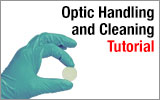

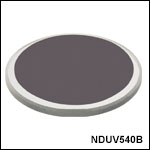
 Zoom
Zoom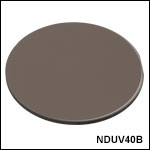
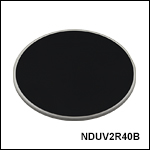
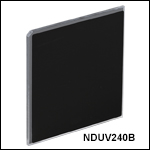
 Unmounted Reflective ND Filters (UV Fused Silica)
Unmounted Reflective ND Filters (UV Fused Silica)